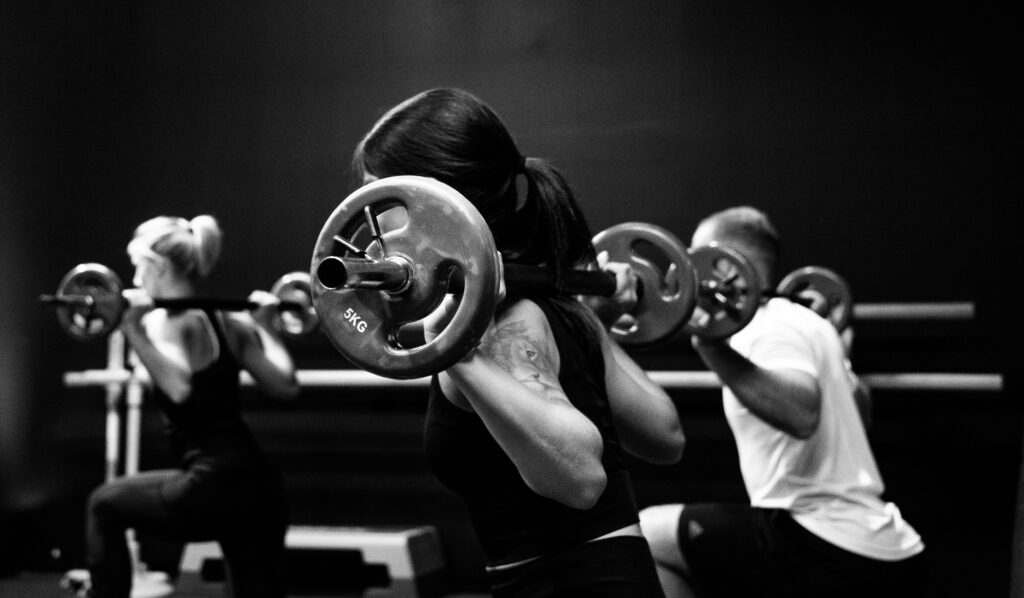High-Intensity Interval Training, or HIIT, is a popular and efficient exercise technique that has recently gained immense popularity. It involves alternating short bursts of intense physical activity with brief rest periods or lower-intensity exercise. HIIT focuses on pushing your body to its limits during intense intervals and then allowing it to recover during rest periods.

How does HIIT Work?
HIIT workouts typically last for 15 to 30 minutes, making them perfect for those with busy schedules. During a session, you engage in high-intensity exercises, such as sprinting, jumping, or burpees, for around 20-60 seconds, followed by a short rest period of about 10-30 seconds. This cycle is repeated several times, depending on your fitness level and the workout’s intensity.

Benefits of HIIT:
- Efficient Fat Burning: HIIT is highly effective for burning fat and calories, even after the workout. The intense intervals push your body to tap into its energy stores and boost your metabolism for hours after the session.
- Time-Saving: HIIT workouts are perfect for people with busy lifestyles, as they offer substantial benefits in a short amount of time. You can get a great workout and achieve your fitness goals without spending hours in the gym.
- Improves Cardiovascular Health: HIIT can enhance cardiovascular fitness by improving heart rate and oxygen consumption. Over time, this can lead to a healthier heart and reduced risk of heart-related diseases.
- Preserves Muscle Mass: Unlike traditional steady-state cardio, which may lead to muscle loss, HIIT helps protect muscle mass while burning fat. This is because the intense intervals stimulate muscle growth and strength.
- No Equipment Necessary: HIIT can be performed using only your body weight, making it accessible and affordable. However, you can also incorporate equipment like dumbbells or resistance bands to add variety and intensity.
Types of Outdoor HIIT Exercises
Here’s a list of HIIT exercises suitable for outdoors:
- Sprints: Find a flat stretch of ground or a track and sprint at maximum effort for 20-30 seconds, followed by a 30-60 seconds rest or walking/jogging.
- Hill Sprints: Sprint up a steep hill or incline for 20-30 seconds, then walk or jog back down to recover.
- Jump Squats: Perform explosive squats, jumping as high as possible and then landing softly. Repeat for 20-30 seconds and rest for 30-60 seconds.
- Burpees: Start standing, drop into a push-up position, do a push-up, jump your feet back to your hands, and explode into a jump. Repeat for 20-30 seconds, and rest for 30-60 seconds.
- Jump Lunges: Perform alternating lunges, but jump and switch legs mid-air instead of switching legs. Repeat for 20-30 seconds, and rest for 30-60 seconds.
- Stair Running: Find a set of stairs and run up them as fast as possible, then walk or jog back down for recovery.
- Bicycle Sprints: Ride your bike as fast as possible for 20-30 seconds, then ride slowly for 30-60 seconds.
- Box Jumps: Find a sturdy box or step, jump onto it, and step back down. Repeat for 20-30 seconds, and rest for 30-60 seconds.
- Shuttle Runs: Set up two markers about 20-30 meters apart. Sprint back and forth between them as quickly as possible for 20-30 seconds and rest for 30-60 seconds.
- Ladder Drills: Set up an agility ladder on the ground and perform various quick and explosive footwork drills, such as high knees, lateral shuffles, and in-and-outs.
- Push-up with Shoulder Tap: Perform a push-up, tap your left hand to your right shoulder, then your right hand to your left shoulder. Repeat for 20-30 seconds, and rest for 30-60 seconds.

Benefits of HIIT
HIIT has numerous benefits, which have contributed to its popularity among fitness enthusiasts and athletes. Here are some of the key benefits:
- Improved cardiovascular health: HIIT helps enhance the efficiency of your heart and lungs, leading to increased cardiovascular endurance. It can reduce the risk of heart disease, lower blood pressure, and improve overall heart health.
- Increased calorie burn: HIIT can lead to significant calorie expenditure during and after the workout. The intense intervals elevate your metabolism, leading to a higher calorie burn even after exercising (known as the “afterburn” effect).
- Time efficiency: HIIT workouts are usually shorter than traditional cardio workouts, yet they can deliver similar or even better results. This makes it a time-efficient option for people with busy schedules who still want to achieve fitness goals.
- Enhanced fat burning: HIIT effectively burns stubborn body fat, particularly abdominal fat. The intense intervals stimulate fat metabolism, improving fat oxidation and weight loss.
- Preservation of muscle mass: Unlike some other forms of cardio, HIIT helps preserve muscle mass because of its shorter duration and focus on intensity. This benefits those looking to maintain or build muscle while improving their cardiovascular fitness.
- Improved insulin sensitivity: HIIT can help improve insulin sensitivity, which is crucial for better blood sugar control. This makes it a valuable exercise option for individuals with or at risk of type 2 diabetes.
- Increased anaerobic capacity: HIIT challenges your anaerobic energy system, leading to increased anaerobic capacity. This can be particularly beneficial for athletes who require short bursts of intense effort in their sports.
- Boost in metabolism: HIIT has been shown to boost your metabolic rate, even after the workout. This means you continue to burn more calories throughout the day, assisting in weight management and overall health.
- Adaptability and variety: HIIT workouts can be easily adapted to different fitness levels, and there is a wide variety of exercises and routines to choose from. This ensures that individuals of various fitness levels and preferences can find a suitable HIIT workout.
- Improved oxygen consumption: HIIT can enhance your body’s ability to utilize oxygen during exercise, which translates to improved athletic performance and endurance.
While HIIT offers numerous benefits, it’s essential to approach it cautiously, especially if you are new to exercise or have certain health conditions. Always consult a healthcare or fitness professional before starting any new exercise regimen to ensure it’s safe and appropriate for your needs and fitness level.
Suitability and Safety:
HIIT is adaptable to various fitness levels, as the intensity can be modified according to individual abilities. Beginners can start with shorter, less intense intervals and gradually progress as they become more comfortable. However, it is essential to remember that HIIT is physically demanding and may not be suitable for everyone. It’s best to consult with a healthcare professional before starting HIIT if you have any existing health conditions or concerns.

Conclusion:
HIIT is known for its efficient fat-burning capabilities. The intense intervals burn calories during the workout and elevate the metabolism for hours after the session, leading to the well-known “afterburn” effect. This post-exercise increase in metabolic rate helps the body continue to burn calories even at rest, making HIIT an excellent option for weight management and weight loss.
One of the most appealing aspects of HIIT is its adaptability to various fitness levels. Whether you are a beginner or a seasoned athlete, HIIT can be tailored to suit your individual needs and goals. Beginners can start with modified or lower-intensity versions of HIIT exercises, gradually increasing the intensity as they build strength and endurance. On the other hand, athletes can incorporate more challenging variations to continuously push their limits and improve performance.
However, while HIIT offers excellent benefits, listening to your body and exercising caution is crucial. As with any workout regimen, starting at your own pace and gradually progressing is essential to prevent injuries and ensure long-term success. If you are new to exercise or have any underlying health conditions, it is advisable to consult with a fitness professional or healthcare provider before beginning a HIIT program.
Seeking guidance from a fitness professional can provide personalized recommendations, ensure proper exercise form, and help design a safe and effective HIIT routine tailored to your fitness level and goals.
In conclusion, High-Intensity Interval Training is a fantastic option for those seeking a time-efficient and effective workout to improve cardiovascular fitness, efficient fat-burning, and overall fitness gains. With its versatility and adaptability, HIIT offers a challenging yet customizable approach to achieving maximum results in minimal time. By approaching HIIT with care, listening to your body, and seeking professional guidance, you can embark on a safe and successful HIIT journey to achieve your fitness objectives.
